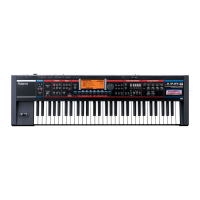9
Live Setting Mode
Let’s take just a moment to look at Live Setting mode. As we
mentioned, this mode’s all about being able to grab patches
and/or performances quickly.
To get to Live Setting mode, press the LIVE SETTTING MODE
button. The LIVE SETTING Screen appears.
Selections 1-6
Banks
Each live set, or “bank,” contains 12 patches, rhythm sets, and/or performances
that you can select by pressing the corresponding F button. Six selections
are displayed at a time. The first six appear by default—you can select any
one by hitting its F button. To view and select from among the next six, hold
down the SHIFT button, and then hit the desired F button.
To go to another bank of 12, use the 6 and 5 buttons.
To learn about saving your own live setting banks, see the JUNO-G Owner’s
Manual.
The JUNO-G Effects
Effects play a large role in the sound of the JUNO-G’s patches, rhythm sets,
and performances. They’re also important in the process of creating songs.
The JUNO-G has seven effect processors you can use:
In FX (for “Input Effect”)—
• This effect allows you to apply effect processing
to audio coming into the JUNO-G from its AUDIO INPUT jacks.
Three MFX (for “Multi-Effects”)—
• The three MFX processors are the most
powerful processors in the JUNO-G. You can use each one to add any
of 78 different effects, as listed on Page 131 of the JUNO-G Owner’s
Manual.
Chorus/Delay—• A global chorus effect, which can be switched to a delay
effect instead if you prefer, is always available.
Reverb—
• There’s also a reverb effect that’s always available.
Mastering—
• When a song is mixed, you can apply the JUNO-G’s
mastering effect to add the final touches to your mix. You can also use
it on the JUNO-G’s overall sound onstage.
Here are a few patches you should listen to to get an idea of what effects
contribute to the JUNO-G’s sounds:
USER-:077 Analog Dream—
• This delicate patch uses a delay MFX.
USER-:148 X-Racer—
• This takes advantage of the MFX Phaser effect.
USER:006 Searing COSM—
• You’ll find Searing COSM in the CATEGORY
screen’s Dist.Guitar category. It uses a face-ripping guitar amp model.
Performance parts—and therefore song tracks—can also take advantage of
all this processing power. Here are a few performances to try out:
USER:002 Clone Zone—
• In this split performance, the left hand’s notes
are going through an MFX phaser, while the right-hand lead line’s going
through a low-fi compressor.
USER: 004 1:00AM—
• In this late-night layered performance, the bells
have a delicate delay, the pad’s spread out by the Space-D MFX, and the
bright keyboard-ish sound’s going through an MFX exciter.
When you’re done listening to effects, hit the PATCH button to return
to the PATCH PLAY screen before proceeding with this booklet.
Exploring the JUNO-G Rhythms
The JUNO-G comes with 256 Preset rhythm patterns—”beats”—that you can
play along with or use in a song. You can also create your own. In the next
few sections, we’ll see and hear how rhythm patterns work.
We’ll explain how to make a song using rhythm patterns a bit later.

